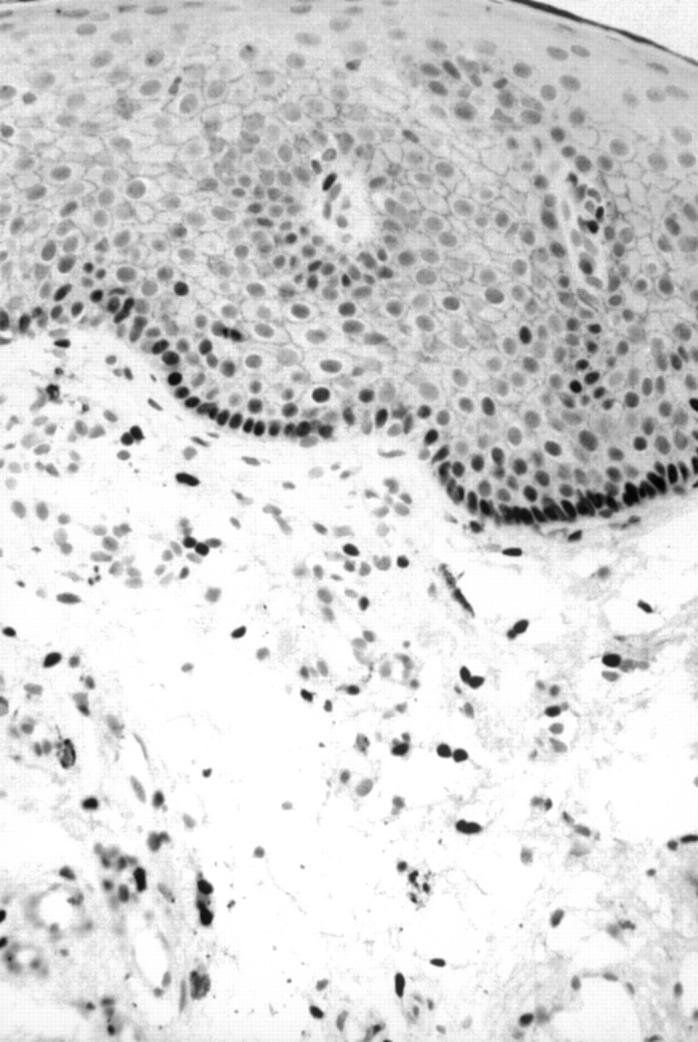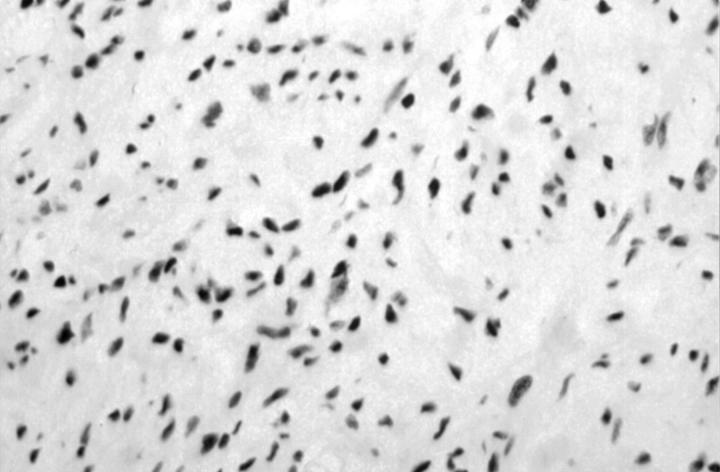Abstract
Aims—Aggressive angiomyxoma of pelvic parts is a distinctive soft tissue tumour that chiefly involves the vulvar and perineal region of female patients. Several previous reports have demonstrated oestrogen receptor (ER) and/or progesterone receptor (PR) positivity in this neoplasm. The aim of this study was to confirm whether ER and/or PR positivity is present in aggressive angiomyxoma. We also wished to ascertain whether positivity may be found in the stromal cells of normal vulval skin and in other lesions at this site that can cause diagnostic confusion with aggressive angiomyxoma.
Methods—Five aggressive angiomyxomas in female patients and one involving male pelvic soft parts were stained immunohistochemically with antibodies against ER and PR. Other samples studied were normal vulval skin (n = 7), fibroepithelial polyps of vulva (n = 7), vulval smooth muscle neoplasms (n = 5), vulval nerve sheath tumours (n = 2), vaginal angiomyofibroblastoma (n = 1), and pelvic myxoma (n = 1). Nuclear staining was classified as negative, weak, moderate, or strong and the proportion of positively staining cells was categorised as 0, < 10%, 10–50%, or > 50%.
Results—All five cases of aggressive angiomyxoma in female patients were positive for ER (two with weak intensity involving < 10% of cells and three with moderate intensity involving 10–50% of cells) and four of five cases were strongly positive for PR in > 50% of cells. The other case was negative for PR. There was no staining with antibodies to ER or PR in the single male patient with aggressive angiomyxoma. Other samples exhibiting positivity of the stromal cells for either ER or PR were normal vulval skin (five of seven, ER; two of seven, PR), fibroepithelial polyps (four of seven, ER; five of seven, PR), smooth muscle neoplasms (three of five, ER; four of five, PR), nerve sheath tumours (one of two, ER; one of two, PR), angiomyofibroblastoma (one of one, ER; one of one, PR), and pelvic myxoma (one of one, PR).
Conclusions—All cases of aggressive angiomyxoma of pelvic soft parts in female patients exhibited positivity for ER and/or PR. Because of its propensity to occur in female patients during the reproductive years, it is possible that aggressive angiomyxoma is a hormonally responsive neoplasm. However, dermal fibroblasts in normal vulval skin and stromal cells in a variety of vulval lesions can also be positive. ER or PR immunoreactivity cannot be used to distinguish aggressive angiomyxoma and its histological mimics.
Key Words: aggressive angiomyxoma • vulva • oestrogen receptor • progesterone receptor • immunohistochemistry
Full Text
The Full Text of this article is available as a PDF (109.1 KB).
Figure 1 Positive staining of stromal cells for the oestrogen receptor in a female patient with aggressive angiomyxoma.
Figure 2 Positive staining of stromal cells for the progesterone receptor in a female patient with aggressive angiomyxoma.

Figure 3 Positive nuclear staining for the oestrogen receptor of basal layers of squamous epithelium of normal vulval skin. There is also positive staining of some dermal fibroblasts.
Selected References
These references are in PubMed. This may not be the complete list of references from this article.
- Bégin L. R., Clement P. B., Kirk M. E., Jothy S., McCaughey W. T., Ferenczy A. Aggressive angiomyxoma of pelvic soft parts: a clinicopathologic study of nine cases. Hum Pathol. 1985 Jun;16(6):621–628. doi: 10.1016/s0046-8177(85)80112-x. [DOI] [PubMed] [Google Scholar]
- Clatch R. J., Drake W. K., Gonzalez J. G. Aggressive angiomyxoma in men. A report of two cases associated with inguinal hernias. Arch Pathol Lab Med. 1993 Sep;117(9):911–913. [PubMed] [Google Scholar]
- Fetsch J. F., Laskin W. B., Lefkowitz M., Kindblom L. G., Meis-Kindblom J. M. Aggressive angiomyxoma: a clinicopathologic study of 29 female patients. Cancer. 1996 Jul 1;78(1):79–90. doi: 10.1002/(SICI)1097-0142(19960701)78:1<79::AID-CNCR13>3.0.CO;2-4. [DOI] [PubMed] [Google Scholar]
- Granter S. R., Nucci M. R., Fletcher C. D. Aggressive angiomyxoma: reappraisal of its relationship to angiomyofibroblastoma in a series of 16 cases. Histopathology. 1997 Jan;30(1):3–10. doi: 10.1046/j.1365-2559.1997.d01-556.x. [DOI] [PubMed] [Google Scholar]
- Havel G., Burian P., Kohrtz M., Mark J. Aggressive angiomyxoma of the vulva: an unusual, deceptive and recurrence-prone tumour with evidence of estrogen receptor expression. Case report. APMIS. 1994 Mar;102(3):236–240. doi: 10.1111/j.1699-0463.1994.tb04870.x. [DOI] [PubMed] [Google Scholar]
- Htwe M., Deppisch L. M., Saint-Julien J. S. Hormone-dependent, aggressive angiomyxoma of the vulva. Obstet Gynecol. 1995 Oct;86(4 Pt 2):697–699. doi: 10.1016/0029-7844(95)00088-9. [DOI] [PubMed] [Google Scholar]
- Iezzoni J. C., Fechner R. E., Wong L. S., Rosai J. Aggressive angiomyxoma in males. A report of four cases. Am J Clin Pathol. 1995 Oct;104(4):391–396. doi: 10.1093/ajcp/104.4.391. [DOI] [PubMed] [Google Scholar]
- Kinzbrunner B., Ritter S., Domingo J., Rosenthal C. J. Remission of rapidly growing desmoid tumors after tamoxifen therapy. Cancer. 1983 Dec 15;52(12):2201–2204. doi: 10.1002/1097-0142(19831215)52:12<2201::aid-cncr2820521204>3.0.co;2-#. [DOI] [PubMed] [Google Scholar]
- MacLean A. B., Nicol L. A., Hodgins M. B. Immunohistochemical localization of estrogen receptors in the vulva and vagina. J Reprod Med. 1990 Nov;35(11):1015–1016. [PubMed] [Google Scholar]
- Nemoto T., Shinoda M., Komatsuzaki K., Hara T., Kojima M., Ogihara T. Myxoid leiomyoma of the vulva mimicking aggressive angiomyxoma. Pathol Int. 1994 Jun;44(6):454–459. doi: 10.1111/j.1440-1827.1994.tb01710.x. [DOI] [PubMed] [Google Scholar]
- Pierce V. E., Jr, Rives D. A., Sisley J. F., Allsbrook W. C., Jr Estradiol and progesterone receptors in a case of fibromatosis of the breast. Arch Pathol Lab Med. 1987 Sep;111(9):870–872. [PubMed] [Google Scholar]
- Rotmensch E. J., Kasznica J., Hamid M. A. Immunohistochemical analysis of hormone receptors and proliferating cell nuclear antigen in aggressive angiomyxoma of the vulva. Int J Gynaecol Obstet. 1993 May;41(2):171–179. doi: 10.1016/0020-7292(93)90701-w. [DOI] [PubMed] [Google Scholar]
- Silverman J. S., Albukerk J., Tamsen A. Comparison of angiomyofibroblastoma and aggressive angiomyxoma in both sexes: four cases composed of bimodal CD34 and factor XIIIa positive dendritic cell subsets. Pathol Res Pract. 1997;193(10):673–682. doi: 10.1016/S0344-0338(97)80026-X. [DOI] [PubMed] [Google Scholar]
- Steeper T. A., Rosai J. Aggressive angiomyxoma of the female pelvis and perineum. Report of nine cases of a distinctive type of gynecologic soft-tissue neoplasm. Am J Surg Pathol. 1983 Jul;7(5):463–475. doi: 10.1097/00000478-198307000-00009. [DOI] [PubMed] [Google Scholar]
- Sutton G. P., Rogers R. E., Roth L. M., Ehrlich C. E. Aggressive angiomyxoma first diagnosed as levator hernia. Am J Obstet Gynecol. 1989 Jul;161(1):73–75. doi: 10.1016/0002-9378(89)90235-4. [DOI] [PubMed] [Google Scholar]
- Tsang W. Y., Chan J. K., Lee K. C., Fisher C., Fletcher C. D. Aggressive angiomyxoma. A report of four cases occurring in men. Am J Surg Pathol. 1992 Nov;16(11):1059–1065. [PubMed] [Google Scholar]




